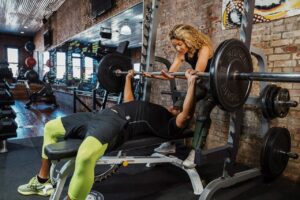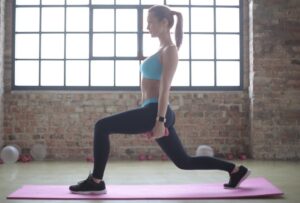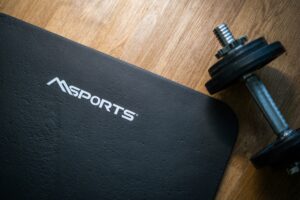The legs also referred to as the lower body, consist of four primary muscle groups: the glutes, quadriceps, hamstrings, and calves.
We did a complete guide for the glutes, which you’re welcome to check out here. Today’s article will focus on the other three muscles.
The quadriceps are the large four-headed muscle that makes up the front thighs. Its primary functions are knee extension (straightening the legs) and hip flexion (bending at the waist) (1).
Your hamstrings are the muscle group that makes up the rear of your thighs, and their functions run opposite to those of the quads: knee flexion (bending the legs) and hip extension (driving the hips forward) (2).
Lastly, we have the calves, which make up the rear of the lower legs and span from the knee to the Achilles tendon. Their primary function is to produce ankle extension (plantar flexion), which means moving the foot downward (3, 4).
Let’s go over the best isolation and compound leg exercises and how to organize them inside an effective training plan.
Compound and Isolation Exercises
Compound exercises are those that simultaneously train several muscle groups and involve two or more joints.
An example of a compound lower body exercise is the barbell back squat. It trains the quadriceps, hamstrings, glutes, calves, midsection, back, shoulders, and arms (5). The joints with an active role include the ankles, knees, and hips.
In contrast, isolation movements focus on a single muscle group and involve one joint. One great example is the leg extension on a machine. The activity targets the quadriceps, and movement occurs at the knee joint.
When to Do Compound or Isolation Exercises
Compound exercises should make up the bulk of your lower body workouts. These activities are more challenging to perform, but they offer unique benefits:
- Great overloading potential – you can gradually increase the difficulty by lifting more weight
- Strength development – working with heavier loads leads to more mechanical tension and greater nervous system stimulation, resulting in more strength
- More significant stimulus – each repetition is more disruptive and promotes better progress
- Efficiency – you train several muscle groups simultaneously, which allows you to create a strong enough stimulus for progress in less time
- Sport-specific benefits – compound movements teach your muscles to work together, which translates to improved athleticism
In addition, compound activities are more complex, and the risk of technique breakdown is greater. Performing them early in your training while you’re still fresh reduces the risk of incorrect form and allows you to perform at your best.
Plan your compound and isolation leg workout and track your progress on the Hevy app.
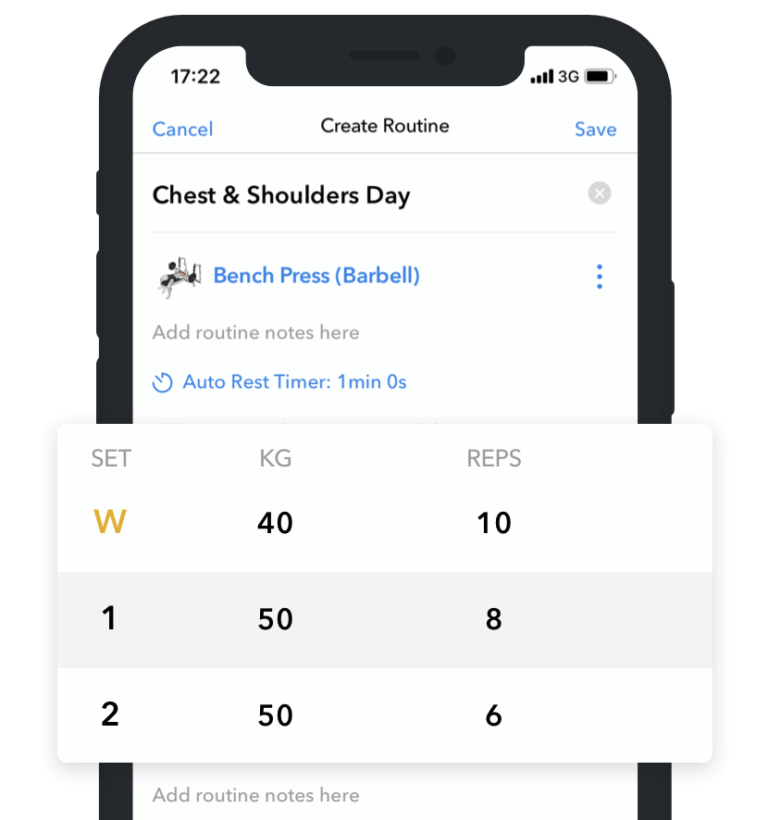





Hevy – Workout Tracker
Create your leg workout with Hevy, and track your progress
Once you’re done with compound exercises, you can finish your workout with some isolation activities. These movements are easier to perform, and the risk of poor form is small, even if you’re tired.
Isolation exercises provide a targeted stimulus and help you accumulate the necessary training volume (primarily measured by counting the number of sets you do) for optimal hypertrophy (6).
Here are a couple of examples of how that might look. The first is a leg workout for people training their lower body once per week, whereas the second is a scenario where someone works out their legs twice weekly.
| Example 1: Leg Workout (Once Weekly Lower Body Training) | ||
| Exercise | Sets | Reps |
| Front Squat | 3 | 6 to 10 |
| Glute Ham Raise | 3 | 8 to 12 |
| Leg Press (Machine) | 3 | 8 to 12 |
| Standing Cable Glute Kickbacks | 3 | 12 to 15 |
| Leg Extension (Machine) | 3 | 12 to 15 |
| Seated Leg Curl (Machine) | 3 | 12 to 15 |
| Standing Calf Raise (Machine) | 3 | 15 to 20 |
The first workout features more exercises because you only train your legs once every seven days and need more sets to promote muscle and strength gain.
| Example 2: Two Leg Workouts Per Week | ||
| Workout A (e.g., Monday) | ||
| Exercise | Sets | Reps |
| Front Squat | 3 | 6 to 10 |
| Seated Leg Curl (Machine) | 3 | 12 to 15 |
| Leg Extension (Machine) | 3 | 12 to 15 |
| Standing Calf Raise (Machine) | 3 | 8 to 15 |
| Workout B (e.g., Thursday) | ||
| Exercise | Sets | Reps |
| Glute Ham Raise | 3 | 8 to 12 |
| Leg Press (Machine) | 3 | 8 to 12 |
| Standing Cable Glute Kickbacks | 3 | 12 to 15 |
| Seated Calf Raise | 3 | 15 to 20 |
As you can see, both workouts follow the same rules. The primary difference is that the overall training volume is split into two sessions in the latter example, allowing for easier workouts and less severe muscle soreness.
Related article: Best Leg Workout and Exercises for a Strong Lower Body
List of 8 Compound Leg Exercises
1. Squat (Barbell)
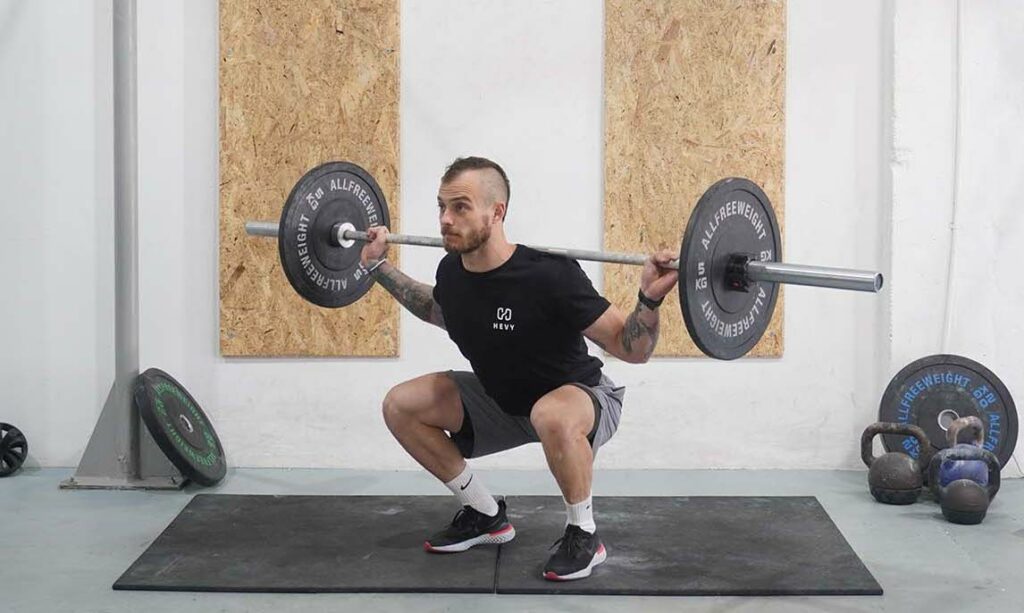

The barbell squat is one of the classic compound leg exercises for impressive muscle and strength gain (5).
While simple, the squat is challenging to master because there are numerous details to consider: bar placement, squat depth, bracing, breathing, descent, pause, maintaining balance, etc.
Taking the time to master the exercise will pay dividends because it overloads multiple muscle groups, including the quadriceps, glutes, and hamstrings.
As a compound exercise, the squat allows you to overload your body with increasingly more weight as you get stronger.
2. Front Squat
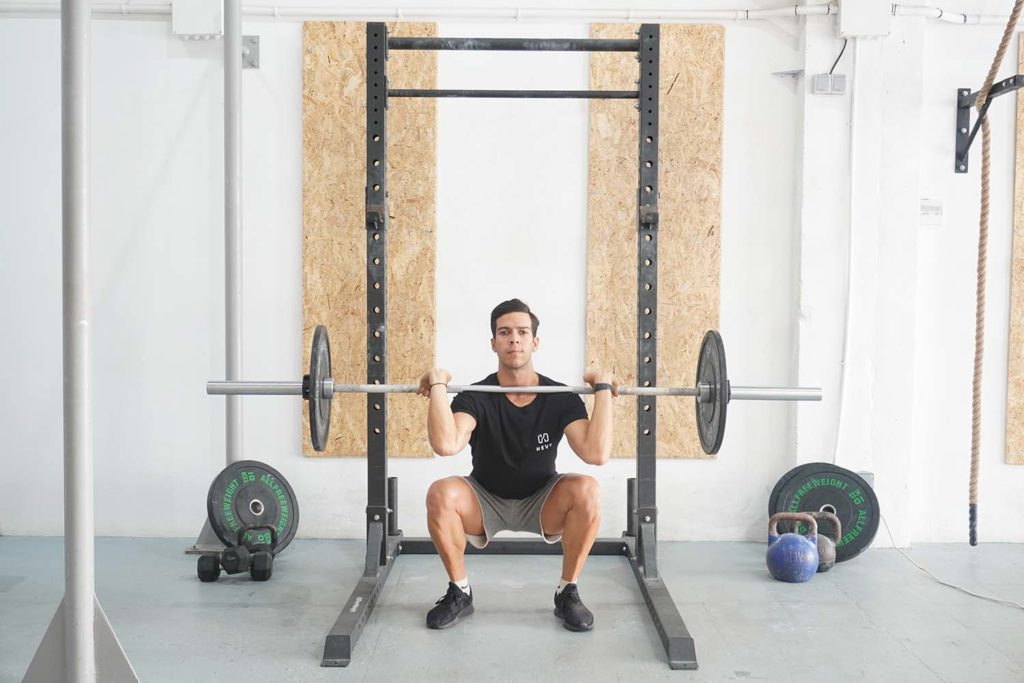

Front squats are another compound leg exercise you can do to strengthen your quadriceps, glutes, and hamstrings (5).
The objective is to support the barbell in a front rack position: resting it on top of your shoulders and supporting it with your fingertips or hands.
A front rack position forces you to maintain a much more upright torso because the barbell would otherwise fall forward. As a result, hip extension occurs to a much smaller degree, and your quadriceps have to do more work for you to complete reps.
Another advantage of front squats is that you strengthen your upper back and midsection because both muscle groups work harder to keep you upright.
3. Bulgarian Split Squat
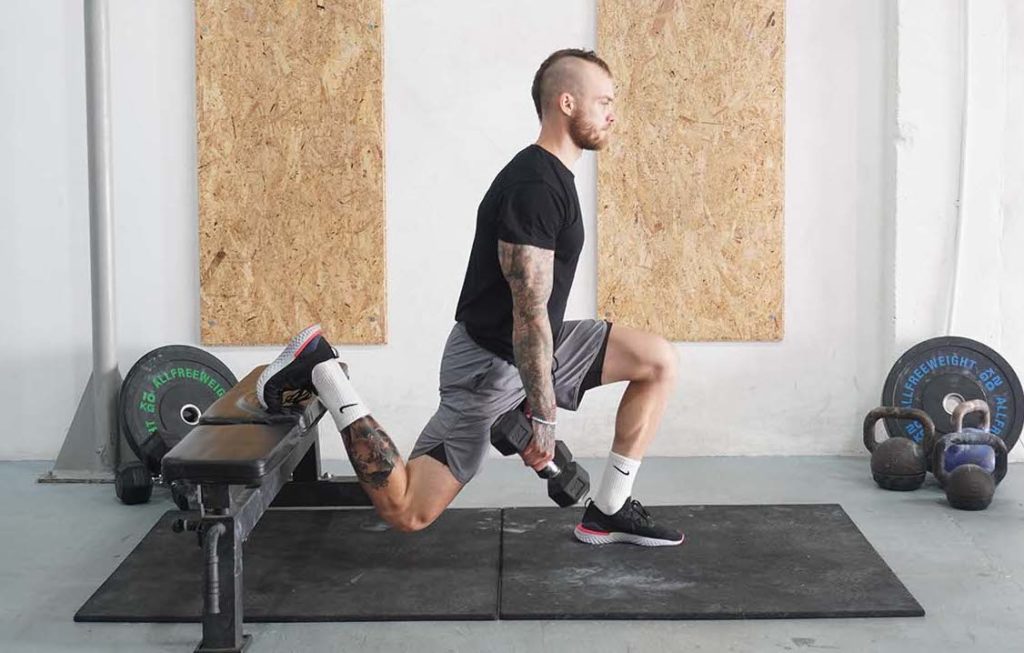

Bulgarian split squats are one of the best compound lower body exercises you can do to strengthen both legs individually.
Have your rear foot elevated on an object (e.g., a flat bench), plant your front foot on the floor, and straighten your upper body. Once in position, engage your core, inhale, and squat by bending your front knee.
Training one leg at a time is excellent for adding equal muscle mass to both sides of your body and reducing the risk of imbalances.
You can begin with the bodyweight version of the exercise and gradually work up to the weighted version by having a bar on your back or holding a pair of weights.
4. Goblet Squat
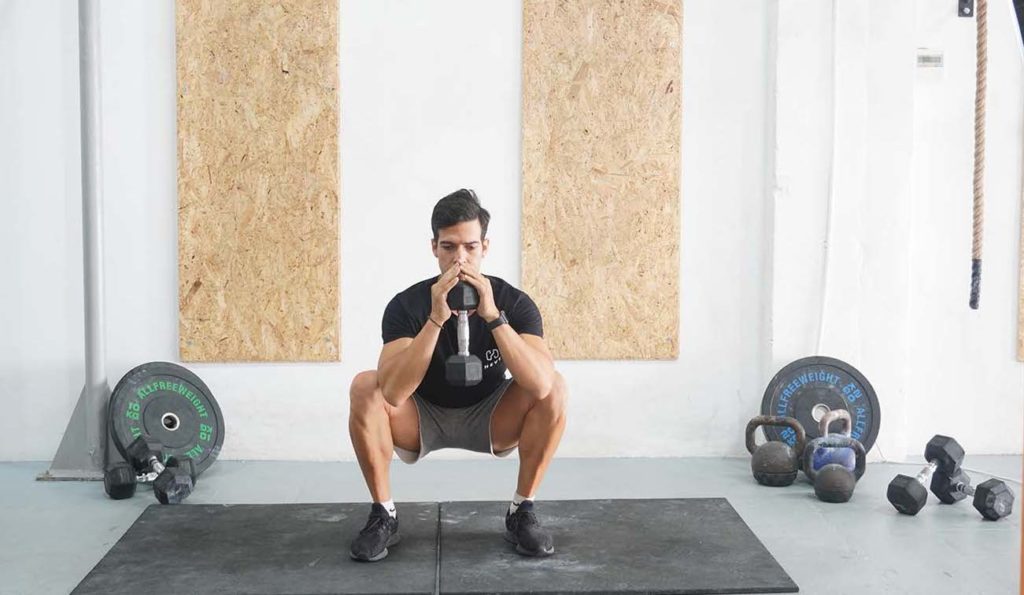

Goblet squats are also among the best leg compound exercises. It develops multiple muscle groups and shares similar mechanics to the front squat.
The objective is to raise a dumbbell or kettlebell in front of your chest and squat. Such a position forces you to maintain an upright upper body to keep the weight over your center of gravity.
Aside from developing the hamstrings, glutes, and quadriceps, goblet squats build your upper back, shoulders, and core muscles.
A wider stance shifts the emphasis to the glutes and adductors (inner thigh muscles), whereas having your feet close leads to better quad engagement.
Related article: The Top Dumbbell Leg Workouts to Attain Powerful Legs
5. Straight Leg Deadlift
The straight (stiff) leg deadlift is an excellent compound exercise that allows you to overload your body with more weight and develop multiple muscles (7).
Straight leg deadlifts are similar to the conventional version apart from one significant difference:
Instead of bending your knees to get into the starting position, you must hinge at the hips and grab the bar while keeping your leg straight, hence the movement’s name. Doing so reduces the involvement from your quadriceps and shifts the focus to the posterior chain: glutes, hamstrings, and back.
Like most deadlift variations, you can work up to respectable weights and provide the necessary overload for muscle growth and strength development.
6. Glute Ham Raise
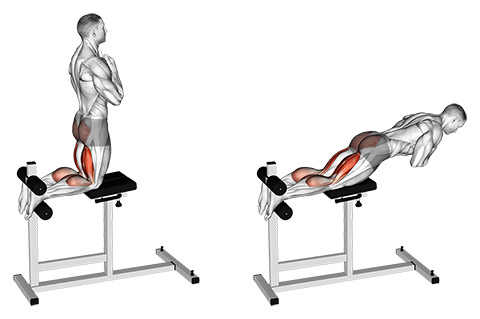

Glute-ham raises are among the best lower-body compound exercises that emphasize the hamstrings, glutes, and lower back (8).
To perform the movement, you must set yourself up on a glute-ham bench with your knees on a padded platform and a pad against your Achilles tendons.
Once in position, engage your upper body and core muscles, inhale, and lower your torso, controlling yourself with your hamstrings. Squeeze your posterior muscles to raise your upper body to an upright position and exhale.
You can make the exercise more challenging by holding a weight plate against your chest.
Related article: 12 of the Best Lower Body Pull Exercises for Strength
7. Romanian Deadlift (Barbell, Dumbbell)
Romanian deadlifts are among the best compound exercises for lower body muscle mass and strength gain (8).
To perform the Romanian deadlift, you must stand tall with a weight in your hands––a barbell or pair of dumbbells.
Engage your back muscles, squeeze your abs, and position your feet shoulder-width apart. Inhale and hinge at the hips to lean your torso forward, loading your hamstrings.
Go down until you feel a decent stretch in your posterior musculature, and straighten your body, squeezing your glutes to complete the repetition.
As a compound leg exercise, the Romanian deadlift offers an excellent overloading potential, allowing you to stay challenged even as you build a lot of strength over the years.
8. Sumo Squat (Barbell)
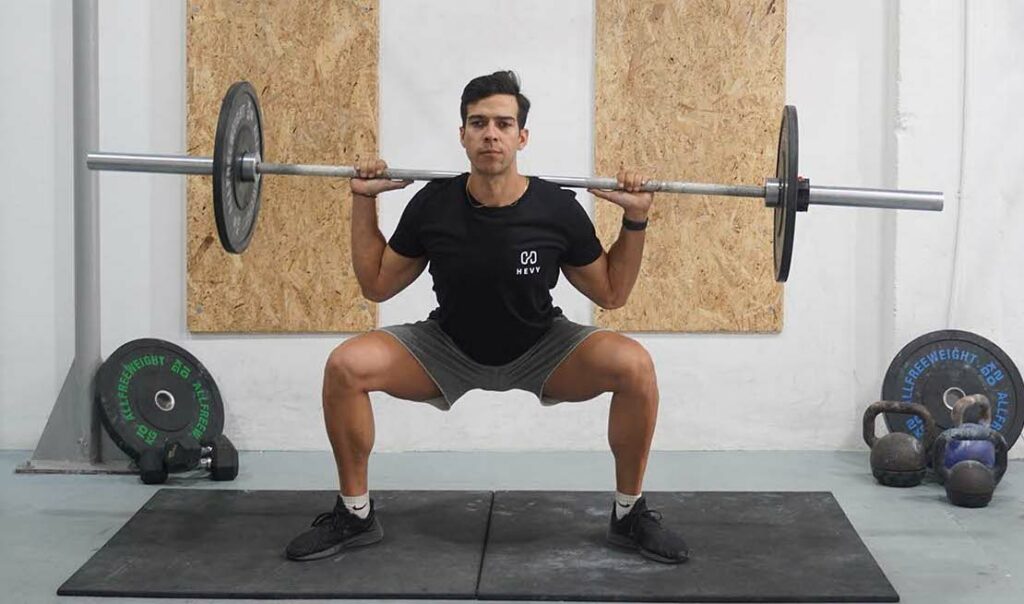

Sumo squats are among the less-known compound movements, which is a shame. When done correctly, the activity develops the legs, back muscles, shoulders, and abs.
The objective is to place a loaded barbell on your upper back, hold it in place with your hands, and assume a wide stance (wider than shoulder-width apart) with your toes pointing out. Once in position, inhale and squat to parallel.
A wider stance is beneficial for targeting the adductors (inner thigh muscles) and can help improve quadriceps activation for taller lifters.
An alternative to the sumo barbell squat is the sumo goblet squat, where you hold a weight in front of your chest and do reps with the same wide stance.
List of 7 Isolation Leg Exercises
1. Leg Extension (Machine)
Machine leg extensions are among the best quad isolation exercises. The exercise is relatively easy to learn, it targets your quadriceps, and the overloading potential is surprisingly good for an isolation exercise.
To perform these, select the appropriate load, sit on a leg extension machine, have your knees just over the edge of the seat, and position the pad against your lower shins. Hold the handles to your sides for support, inhale, and extend your knees.
Leg extensions work great as one of the last exercises in your workout routine. You can do more reps to produce enough metabolic stress and stimulate hypertrophy.
The single-leg version, where you work one side at a time, can help increase muscle activation and prevent muscle imbalances.
2. Leg Press (Machine)
Leg presses are also among the best isolation exercises for quad development and strength gain.
A notable difference between leg presses and other movements is that you can use a lot of weight and overload your muscles to get stronger. The range of motion is also excellent.
To perform these, sit inside a leg press machine, place your feet on the platform, engage your abs, and inhale. Once in position, unrack the weight via the handles to your sides and slowly bend your knees before pressing the platform away.
You can do the leg press at any point in your workout routine: early in your sessions, using more weight, or near the end, doing high-rep ‘burnout’ sets.
Related articles: 11 Leg Press Alternative Exercises for Mass and Strength
3. Lying Leg Curl (Machine)
Lying leg curls are among the classic hamstring isolation exercises. The movement isolates your posterior thigh muscles through knee flexion (bending of the legs).
Unlike other isolation movements for the legs, the leg curl doesn’t allow you to use as much weight, but it still provides an excellent stimulus, so long as you train through the full range of motion (9).
To perform these, select the appropriate load on the machine, lie face down, and have the pad against your Achilles tendons (just above the heels). Grab the handles for support, inhale, and curl the weight by flexing your posterior thigh muscles. Squeeze at the top and slowly extend your legs as you exhale.
4. Seated Leg Curl (Machine)
Seated leg curls are similar to lying leg curls, apart from one significant difference:
Instead of training your hamstrings from a lying position, you’re seated, similar to leg extensions.
A seated position allows for greater hip flexion, theoretically leading to better hamstring activation (9). We recommend trying both versions to determine which suits you better.
To perform these, sit on a leg curl machine. The top pad should be over your thighs and just behind the knees, and the lower pad should be against your Achilles tendons, just above the heels.
Once set up, grab the handles and repeatedly flex and extend your knees to train your hamstrings.
5. Nordic Hamstring Curl
The Nordic hamstring curl is a bodyweight isolation exercise that offers numerous strength training benefits.
One notable advantage is that you can train your hamstrings through knee flexion even if you don’t have access to a machine (10). Instead of lifting external weight, you use your body weight for resistance.
Another benefit is that Nordic curls force greater core activation, which can improve hip and ab stability.
To perform these, anchor your feet by putting them underneath a heavy object, such as the bar of a Smith machine, set to the lowest position. Alternatively, have a training partner hold your feet down.
Begin with an upright torso, bring your shoulders back, and engage your abs. Inhale and slowly lower your torso by extending your knees. Go down as much as your strength allows and flex your hamstrings to curl your torso to the starting upright position.










Hevy – Workout Tracker
Create your leg workout with Hevy, and track your progress
6. Hip Adduction (Machine)
Hip adductions are a simple and effective movement that strengthens the outer thigh and glute muscles.
The objective is to sit on a machine with your outer thighs against pads and knees a few inches apart. Inhale and engage your glute musculature to spread your knees in one fluid motion.
A notable benefit of the movement is that you can control the resistance. Do fewer reps to promote strength gain or perform high-rep ‘burnout’ sets near the end of your training.
Related article: Top 15 Gluteus Minimus Activation Exercises
7. Calf Raises (Seated & Standing)
Seated and standing calf raises are excellent isolation exercises for the gastrocnemius and soleus. These two muscles make up the calves and cover the rear of the lower legs.
Performing standing calf raises is excellent for the gastrocnemius, whereas seated calf raises emphasize the soleus. It’s best to perform both variations for optimal calf development.
For instance, if you train your legs twice per week, do standing calf raises at the end of the first workout and seated raises to finish the second.
Final Words
The above are some of the best isolation and compound exercises for lower body strength and muscle growth.
Some of the movements are more common and widely used, whereas others often go unnoticed by most trainees.
We recommend trying the above movements to see what works best in your training.
Other articles from the series:
- The Top 7 Isolation And 7 Compound Ab Exercises
- 10 Compound and 4 Isolation Back Exercises for an Impressive V-Taper
- 8 Isolation and 7 Compound Bicep Exercises For Big Arms
- 8 Compound and 6 Isolation Chest Exercises for Strong Pecs
- 5 Isolation and 9 Glute Compound Exercises for a Head-Turning Behind
- 8 Isolation and 9 Compound Shoulder Exercises
- 7 Isolation and 7 Compound Tricep Exercises For Big Arms


